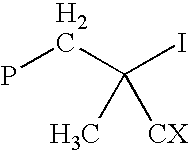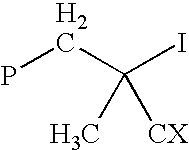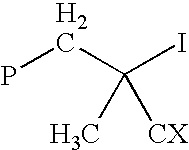Method for polymerizing ethylenically unsaturated monomers by degenerative iodine transfer
- Summary
- Abstract
- Description
- Claims
- Application Information
AI Technical Summary
Benefits of technology
Problems solved by technology
Method used
Image
Examples
example 1
[0048]A reaction vessel was charged with 21.25 g of MMA, 5.32 g of BA, 20 g of butyl acetate, 1.54 g of I2, and 2.258 g of 2,2′-azobis(2,4-dimethylvaleronitrile), degassed, and maintained under a nitrogen atmosphere. The temperature was raised to 67° C., and the reaction was continued for 8 h. After 1 h and 40 min, the brown iodine colour was observed to fade, an observation that coincided with a steep increase of conversion with time, after the inhibition period in the presence of molecular iodine. SEC analysis of a sample taken after this period (conversion 88%) yields an Mn of 2,325 and an Mw / Mn of 1.31, Mz / Mw 1.25.
example 2
[0049]A reaction vessel was charged with 15.96 g of MMA, 10.66 g of BA, 20 g of butyl acetate, 1.53 g of I2, and 2.26 g of 2,2′-azobis(2,4-dimethylvaleronitrile), degassed, and maintained under a nitrogen atmosphere. The temperature was raised to 64° C., and the reaction was continued for 8 h. After 2 h the brown iodine colour was observed to fade, an observation which coincided with a steep increase of conversion with time, after the inhibitive period in the presence of molecular iodine. SEC analysis of a sample taken after this period (conversion 82%) yields an Mn of 2,210 and an Mw / Mn of 1.48, Mz / Mw 1.47.
example 3
[0050]A reaction vessel was charged with 10.62 g of MMA, 15.96 g of BA, 20 g of butyl acetate, 1.53 g of I2, and 2.267 g of 2,2′-azobis(2,4-dimethylvaleronitrile), degassed, and maintained under a nitrogen atmosphere. The temperature was raised to 64° C., and the reaction was continued for 20 h. After 2 h, the brown iodine colour was observed to fade. SEC analysis of a sample taken after this period (conversion 95%) yields an Mn of 2,430, an Mw / Mn of 2.04, and an Mz / Mw of 2.16.
PUM
| Property | Measurement | Unit |
|---|---|---|
| Temperature | aaaaa | aaaaa |
| Temperature | aaaaa | aaaaa |
| Temperature | aaaaa | aaaaa |
Abstract
Description
Claims
Application Information
 Login to View More
Login to View More - R&D
- Intellectual Property
- Life Sciences
- Materials
- Tech Scout
- Unparalleled Data Quality
- Higher Quality Content
- 60% Fewer Hallucinations
Browse by: Latest US Patents, China's latest patents, Technical Efficacy Thesaurus, Application Domain, Technology Topic, Popular Technical Reports.
© 2025 PatSnap. All rights reserved.Legal|Privacy policy|Modern Slavery Act Transparency Statement|Sitemap|About US| Contact US: help@patsnap.com



